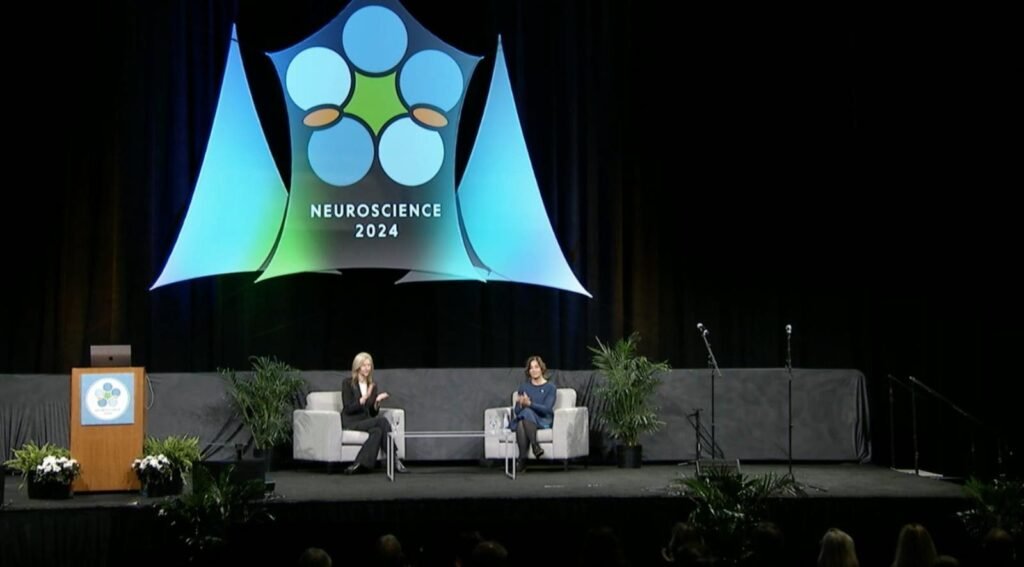The annual meeting of the Society for Neuroscience (SfN) is currently being held in Chicago. Thousands of neuroscientists gather here to discuss the latest topics in neuroscience research. They talk about new ways to understand the brain, how to help people with neurodegenerative diseases, artificial intelligence and how it can be used to support research. But the conference started with a presentation about art.
This large annual gathering of neuroscientists has always put more of a spotlight on the arts than many other scientific conferences. Each year, a group of artists are invited to exhibit and sell neuroscience-themed art at the conference. But this year, the conference also kicked off with a two-hour session on the neuroscience of art.
Susan Magsamen (left) speaks about the neuroscience of art with Marina Picciotto at the Society for… (+) Neuroscience conference on October 5, 2024. Image from the conference livestream.
Neuroscience Society
Susan Magsamen, director of the Johns Hopkins International Arts and Mind Lab, highlighted the burgeoning field of neuroart research in her opening lecture earlier today. She presented some data from the Penn Center for Neuroaesthetics, showing that more and more scientists are now studying the overlap between neuroscience and aesthetics. This is a field of research that studies how our brains respond to art and other things we find pleasing to look at.
Another area of active research is music and neuroscience. Francis Collins, former director of the National Institutes of Health (NIH), founded the Sound Health Initiative. This is a collaboration between the NIH and the National Symphony Orchestra (NSO) to learn more about the relationship between music and health.
Magsamen explained that the importance of art to mental health makes it valuable for research. The more research there is, the clearer the value of art becomes. She listed several areas where there is already ample evidence of the effects of the arts on health. For example, the Mark Morris Dance Group has participated in dozens of research papers on using dance to support people with Parkinson’s disease. There is also growing evidence from several different research groups that singing helps people with Alzheimer’s disease. Additionally, an ongoing initiative called “Creative Forces” uses evidence-based art therapy to support military personnel and veterans with mental health issues.
After his speech, Mr. Magsamen took to the stage with SfN President Marina Picciotto. Magsamen said during the discussion that much research remains to be done regarding the intersection of art and science. She mentioned a report by researchers at University College London that identified more than 600 ways the arts can impact health. This also means there are still many new areas in which researchers can study the effects of the arts on health.
“There’s a lot of work to do,” Magsamen said. That’s why, with Ruth Katz, she co-directed the NeuroArts Blueprint, a collection of guidelines and resources for researchers working at the interface of science and art. As Magsamen explained, there is already a lot of research being done, but they wanted to create a more centralized community for that research. This will be followed by the opening of a Neuroarts resource center in the coming months.
In conjunction with the theme of improving mental health through music, the conference session also invited musicians Jonas Fridl, Anna Jacobsen and Andrew Wilkins to take to the stage. They led the crowd in a collaborative performance of “You May Leave, but This Will Bring You Back,” originally by the Memphis Jug Band. Everyone in the audience was given a kazoo and taught how to play a few repeated lines so they could participate in the performance.
… (+) Jonas Fridl, Andrew Wilkins, and Anna Jacobsen perform at the Society for Neuroscience Conference on October 5, 2024. Image from the conference livestream.
Neuroscience Society
The Kazoo movement gave the neuroscientists at the conference the opportunity to experience first-hand the impact of music production on mental health. Everyone ended up keeping their kazoos, which boded well for the next few days of research discussions at the conference.

